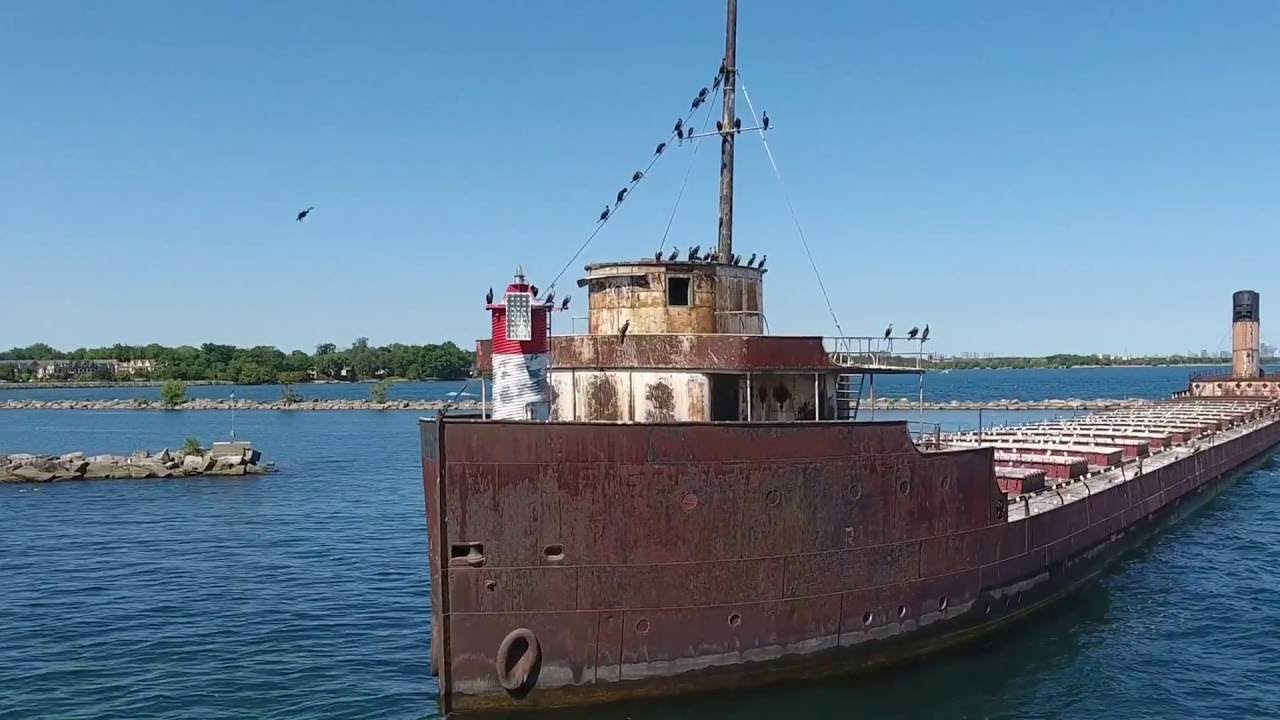Last week I received an inquiry asking about the Ridgetown, the Great Lakes freighter that serves today as the breakwater for the harbour at Port Credit. Back on a May episode of Ask A Historian, I answered a question asking about the Ridgetown, and while I initially directed the inquiry to the YouTube video from May 28, it occurred to me that I should commit to writing the story down as others might be curious about this local landmark (now I am pondering if “landmark” is the correct term for a ship, but “watermark” does not seem to fit).

Since 1974 the Ridgetown has been a familiar sight at the entrance to the Port Credit harbour. For many residents it is hard to remember a time when she was not guarding the mouth of the Credit River. But the Ridgetown lived a long life plying her trade on the Great Lakes as a bulk freighter long before she came to be sunk as a breakwater at Port Credit in 1974. For those with keen eyes (and a boat), you might catch glimpses today of fading paint on the Ridgetown that hint at another name for the ship.

The Ridgetown was built as the S.S. William E. Corey. She was a steel-hulled propeller-driven Great Lakes freighter. The William E. Corey was built by the Chicago Shipbuilding Company and was launched on June 24, 1905. She served as the flagship for the Pittsburgh Steamship Company and sailed out of Cleveland, Ohio. Today she is the fourth-oldest surviving great lakes freighter (or “laker” as they are known).
She was the near sister-ship to the Henry C. Frick (in service between 1905 and 1972, renamed Michipicoten in 1964, retired and wrecked in 1972), Elbert H. Gary (in service between 1905 and 1972, renamed R.E. Webster in 1964, scrapped in 1973) and the George W. Perkins (in service between 1905 and 1981, renamed Westdale in 1964, sold to Pierson Steamships Ltd. of Mississauga and renamed H.C. Heimbecker in 1977, scrapped in 1981).
The Corey, the second ship of the four sisters to be launched, sailed from Chicago on her maiden voyage on August 12, 1905 bound for Duluth, Minnesota to take on a load of iron ore.
One fascinating story about the Corey / Ridgetown came during her first few months of service as the Corey. The Corey was one of many ships caught in the infamous “Mataafa Blow” on Lake Superior on November 28, 1905. During the hurricane-force storm, the Corey was driven hard aground onto the Gull Island Reef in the Apostle Islands on Lake Superior. The storm raged for three days, wrecked 30 vessels, and claimed the lives of 78 sailors. Ships lost in the storm included Lafayette, William Edenborn, Madeira, George Herbert, Vega, J.H. Outhwaite, Ira H. Owen, Monkshaven, and Mataafa, amongst others. Many mariners called the Mataafa Blow the worst “Witch of November” storm on the Great Lakes.
The Corey survived, barely. After taking a terrible beating, a massive effort was required to free her. At one time the salvage force included 158 men, four steamers and two tugs. On December 10, 1905 the Corey was finally pulled free and refloated. The cost of salvage and repairs totaled $100,000. The Corey was reconstructed and resumed service in mid-1906.

The Corey, having sailed the Great Lake for just over 54 years, was laid up at Duluth in early 1960. In 1963 the Corey was sold the Upper Lakes Shipping Company and renamed Ridgetown. The ageing Ridgetown served for several more years, until she was laid up in Toronto on November 17, 1969, effectively ending her career. The Corey / Ridgetown had faithfully traversed the Great Lakes for 64 years. In May of 1970 she was sold to the Canadian Dredge and Dry Dock Company. Ltd. of Toronto, and was brought to Nanticoke and scuttled as a temporary breakwater. Later refloated, the Ridgetown was brought to Port Credit on June 21, 1974, where she was loaded with stone and cement and sunk to become a permanent breakwater. The ship registry for the Ridgetown was closed on June 19, 1974.
NOTE: This story was previously published as part of the Way Back Wednesday series in Modern Mississauga by Heritage Mississauga.
It can be found on their website here: https://www.modernmississauga.com/main/2020/8/12/the-history-of-mississaugas-great-lakes-freighter-the-ridgetown



Comments are closed.